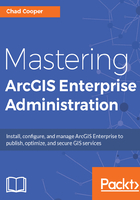
What constitutes an enterprise geodatabase?
A geodatabase is a spatially-enabled database. Within the ArcGIS Enterprise framework, there are three types of geodatabases:
- Personal geodatabase: This uses Microsoft Access for data storage, and it has a size limit of 2GB.
- File geodatabase: This uses the file system folder for storage of GIS datasets; each dataset can be 1TB in size. If not using an enterprise geodatabase, this is the recommended file-based storage type.
- Enterprise geodatabase: This uses a relational database management system (RDBMS) for data storage, supports multiple simultaneous user connections, and is limited in size by the RDBMS.
Personal and file geodatabases are intended for single users and small workgroups with one writer and multiple readers, where concurrent user connections eventually degrade performance with more and more readers. File geodatabases can have only one editor per feature dataset, stand-alone feature class, or table. For medium to large organizations needing multiple writers and larger numbers of concurrent readers, an enterprise geodatabase is the optimal choice.
Using an enterprise geodatabase allows you to do the following:
- Bring your own Esri-supported RDBMS license for use in the ArcGIS Enterprise ecosystem
- Be limited on database size and number of connections only by your RDBMS
- Handle security within the RDBMS
- Utilize the RDBMS functionality such as versioning, backup and recovery, replication, SQL support, and high availability
Considering the preceding functionalities that an enterprise geodatabase offers, it is easy to see the advantages offered by an enterprise geodatabase. At 10.5, ArcGIS Enterprise supports the following relational database management systems and versions:
